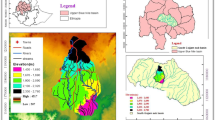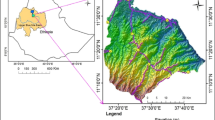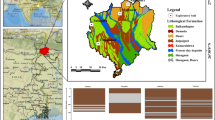Abstract
This study utilizes for the first time integrated knowledge-driven and data-driven methods for groundwater potential zoning in the hard-rock terrain of Ahar River catchment, Rajasthan, India by employing remote sensing, geographical information system, multi-criteria decision making (MCDM), and multiple linear regression (MLR) techniques. Thematic maps of the 11 hydrological/hydrogeological factors i.e., geomorphology, soil, topographic elevation, slope, drainage density, proximity to surface waterbodies, pre- and post-monsoon groundwater depths, net recharge, transmissivity, and land use/land cover, influencing the groundwater occurrence were used. The themes and their features were assigned suitable weights, which were normalized by the MCDM technique. Finally, the knowledge-driven groundwater potential map, generated by weighted linear combination, revealed that the good, moderate and poor groundwater potential zones are spread over 90.94 km2 (26 %), 135 km2 (39 %) and 122.36 km2 (35 %), respectively. Furthermore, the data-driven precise groundwater potential index (GPI) map was computed by MLR technique. The results of both the knowledge- and data-driven approaches were validated from the well yields of 18 sites and were found to be comparable to each other. Moreover, exogenous and endogenous factors affecting the good, moderate and poor groundwater potential were identified by applying principal component analysis. The results of the study are useful to water managers and decision makers for locating appropriate positions of new productive wells in the study area. The novel approach and findings of this study may also be used for developing policies for sustainable utilization of the groundwater resources in other hard-rock regions of the world.















Similar content being viewed by others
References
Adiat KAN, Nawawi MNM, Abdullah K (2012) Assessing the accuracy of GIS-based elementary multi criteria decision analysis as a spatial prediction tool—a case of predicting potential zones of sustainable groundwater resources. J Hydrol 440–441:75–89
Amer R, Sultan M, Ripperdan R, Ghulam A, Kusky T (2013) An integrated approach for groundwater potential zoning in shallow fracture zone aquifers. Int J Remote Sens 34(19):6539–6561
Bonham-Carter GF (1994) Geographic information systems for geoscientists—modelling with GIS, 1st edn. Pergamon, Ontario
Brown AG (1996) Geomorphology and groundwater. Wiley, New York
CGWB (2011) Dynamic ground water resources of India (as on 31 March 2009). Central Ground Water Board (CGWB), Ministry of Water Resources, Government of India, New Delhi
Chowdhury A, Jha MK, Chowdary VM, Mal BC (2009) Integrated remote sensing and GIS-based approach for assessing groundwater potential in West Medinipur district, West Bengal, India. Int J Remote Sens 30(1):231–250
Chowdhury A, Jha MK, Chowdary VM (2010) Delineation of groundwater recharge zones and identification of artificial recharge sites in West Medinipur district, West Bengal, using RS, GIS and MCDM techniques. Environ Earth Sci 59:1209–1222
Deepika B, Kumar A, Jayappa KS (2013) Integration of hydrological factors and demarcation of groundwater prospect zones: insights from remote sensing and GIS techniques. Environ Earth Sci 70(3):1319–1338
Dillon R, Goldstein M (1984) Multivariate analyses: methods and applications. Wiley, New York
Ettazarini S (2007) Groundwater potentiality index: a strategically conceived tool for water research in fractured aquifers. Environ Geol 52:477–487
Haan CT (2002) Statistical methods in hydrology. Iowa State Press, Iowa
ILWIS (2001) Integrated land and water information system, 3.2 academic, user’s guide. International Institute for Aerospace Survey and Earth Sciences (ITC), The Netherlands, pp 428–456
Jain BL, Singh RS, Shyampura RL Gajbhiye KS (2005) Land use planning of Udaipur district – soil resource and agro-ecological assessment. NBSS Publication No. 113, National Bureau of Soil Survey & Land Use Planning, Nagpur, 69 p
Jha MK, Chowdary VM, Chowdhury A (2010) Groundwater assessment in Salboni Block, West Bengal (India) using remote sensing, geographical information system and multi-criteria decision analysis techniques. Hydrogeol J 18(7):1713–1728
Krishnamurthy J, Venkatesa Kumar N, Jayaraman V, Manuvel M (1996) An approach to demarcate groundwater potential zones through remote sensing and a geographical information system. Int J Remote Sens 17(10):1867–1884
Kumar R, Singh RD, Sharma KD (2005) Water resources of India. Curr Sci 89(5):794–811
Lachassagne P, Wyns R, Bérard P, Bruel T, Chéry L, Coutand T, Desprats J-F, Strat PL (2001) Exploitation of high-yields in hard-rock aquifers: downscaling methodology combining GIS and multicriteria analysis to delineate field prospecting zones. Ground Water 39(4):568–581
Lee S, Song K-Y, Kim Y, Park I (2012) Regional groundwater productivity potential mapping using a geographic information system (GIS) based artificial neural network model. Hydrogeol J 20(8):1511–1527
Liu C-W, Lin K-H, Kuo Y-M (2003) Application of factor analysis in the assessment of groundwater quality in a blackfoot disease area in Taiwan. Sci Total Environ 313:77–89
Machiwal D, Jha MK (2014) Characterizing rainfall-groundwater dynamics in a hard-rock aquifer system using time series, geographic information system and geostatistical modelling. Hydrol Process 28:2824–2843
Machiwal D, Srivastava SK, Jain S (2010) Estimation of sediment yield and selection of suitable sites for soil conservation measures in Ahar river basin of Udaipur, Rajasthan using RS and GIS techniques. J Indian Soc Remote Sens 38(4):696–707
Machiwal D, Jha MK, Mal BC (2011a) Assessment of groundwater potential in a semi-arid region of India using remote sensing, GIS and MCDM techniques. Water Resour Manage 25(3):1359–1386
Machiwal D, Nimawat JV, Samar KK (2011b) Evaluating efficacy of groundwater level monitoring network by graphical and multivariate statistical techniques. J Agric Eng ISAE 48(3):36–43
Machiwal D, Mishra A, Jha MK, Sharma A, Sisodia SS (2012) Modeling short-term spatial and temporal variability of groundwater level using geostatistics and GIS. Nat Resour Res 21(1):117–136
Madrucci V, Taioli F, de Araújo CC (2008) Groundwater favorability map using GIS multicriteria data analysis on crystalline terrain, São Paulo State, Brazil. J Hydrol 357:153–173
Malczewski J (1999) GIS and multicriteria decision analysis. Wiley, New York
Mall RK, Gupta A, Singh R, Singh RS, Rathore LS (2006) Water resources and climatic change: an Indian perspective. Curr Sci 90(12):1610–1626
Mitchell TM (1977) Machine learning. Mc-Graw Hill, Singapore
Moore RB, Schwarz GE, Clark SF Jr, Walsh GJ, Degnan JR (2002) Factors related to well yield in the fractured-bedrock aquifer of New Hampshire. US Geological Survey Professional Paper 1660. US Department of the Interior, US Geological Survey, USA, p 51
Nag SK, Ghosh P (2013) Delineation of groundwater potential zone in Chhatna Block, Bankura District, West Bengal, India using remote sensing and GIS techniques. Environ Earth Sci 70(5):2115–2127
Nampak H, Pradhan B, Manap MA (2014) Application of GIS based data driven evidential belief function model to predict groundwater potential zonation. J Hydrol 513:283–300
Oberlander TM (1989) Slope and pediment systems. In: Thomas DSG (ed) Arid zone geomorphology. Belhaven, London, pp 58–59
Pothiraj P, Rajagopalan B (2013) A GIS and remote sensing based evaluation of groundwater potential zones in a hard rock terrain of Vaigai sub-basin, India. Arab J Geosci 6(7):2391–2407
Saaty TL (1980) The analytic hierarchy process: planning, priority setting, resource allocation. McGraw-Hill, New York
Sander P (1997) Water-well sitting in hard-rock areas: identifying promising targets using a probabilistic approach. Hydrogeol J 5:32–43
Shekhar S, Pandey AC (2014) Delineation of groundwater potential zone in hard rock terrain of India using remote sensing, geographical information system (GIS) and analytic hierarchy process (AHP) techniques. Geocarto Int. doi:10.1080/10106049.2014.894584
Singh S (2002) Water management in rural and urban areas. Agrotech Publishing Academy, Udaipur
Singh PK, Kumar S, Singh UC (2011) Groundwater resource evaluation in the Gwalior area, India, using satellite data: an integrated geomorphological and geophysical approach. Hydrogeol J 19:1421–1429
Singh P, Thakur JK, Kumar S (2013) Delineating groundwater potential zones in a hard-rock terrain using geospatial tool. Hydrol Sci J 58(1):213–223
Solomon S, Quiel F (2006) Groundwater study using remote sensing and geographic information systems (GIS) in the central highlands of Eritrea. Hydrogeol J 14:729–741
Subba Rao N (2006) Groundwater potential index in a crystalline terrain using remote sensing data. Environ Geol 50:1067–1076
Thornbury WD (1986) Principles of geomorphology. Wiley Eastern, New Delhi
USGS (2004) Shuttle radar topography mission, 1 arc second scene SRTM_u03_n008e004, unfilled unfinished 2.0. Global Land Cover Facility, University of Maryland, College Park (February 2000)
Acknowledgments
The authors gratefully acknowledge All India Coordinated Research Project on Groundwater Utilization, College of Technology and Engineering, MPUAT, Udaipur, India for providing necessary groundwater-level and pumping-test data for the present study. They are also very thankful to four anonymous reviewers and the editor for providing constructive comments and suggestions, which improved the quality of earlier version of this paper.
Author information
Authors and Affiliations
Corresponding author
Rights and permissions
About this article
Cite this article
Machiwal, D., Rangi, N. & Sharma, A. Integrated knowledge- and data-driven approaches for groundwater potential zoning using GIS and multi-criteria decision making techniques on hard-rock terrain of Ahar catchment, Rajasthan, India. Environ Earth Sci 73, 1871–1892 (2015). https://doi.org/10.1007/s12665-014-3544-7
Received:
Accepted:
Published:
Issue Date:
DOI: https://doi.org/10.1007/s12665-014-3544-7




